Lung Cancer Stages
Lung cancer stages allow doctors to note how far the cancer has spread in your body. From there, they can recommend treatments based on the stage. There are five stages of non-small cell lung cancer and two stages of small cell lung cancer. Learn about the different lung cancer stages below.
What Are the Stages of Lung Cancer?
There are different lung cancer stages depending on what type of lung cancer you have.
Many will be diagnosed with non-small cell lung cancer (NSCLC) as it is the most common type. Doctors have identified five lung cancer stages for NSCLC, from stage 0 (the least advanced and easiest to treat) to stage IV (the most advanced).
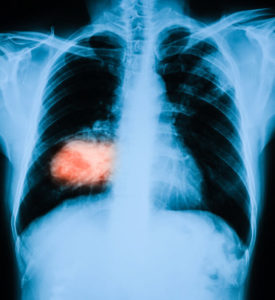
The second most common type of lung cancer is small cell lung cancer (SCLC), and it’s usually classified into one of two stages: limited or extensive.
Lung cancer stages are important as they affect which treatments a patient can receive and how long a patient can expect to live for. Early-stage lung cancer patients often live longer as the cancer hasn’t spread to other parts of the body, and thus it’s easier to treat.
Though many patients are diagnosed in the later stages of lung cancer, treatments can help at any stage. Even some of those with late-stage lung cancer have gone on to become long-term survivors with medical care.
Lung Cancer Group may be able to help you afford treatments for lung cancer, no matter which stage you were diagnosed in. Learn more right now with a free case review.
- Access Financial Aid and Justice
- Learn About Your Options
- Contact Us for Free

Non-Small Cell Lung Cancer Stages
Doctors use the tumor node metastasis (TNM) system to stage non-small cell lung cancer, and there are five stages with this system.
The TNM system allows doctors to classify the size of the tumor (T), if the tumors have reached lymph nodes (N), and if the tumors have metastasized (spread) to other parts of the body (M).
Larger NSCLC tumors that have spread far are considered to be at a more advanced stage and will be harder to treat.
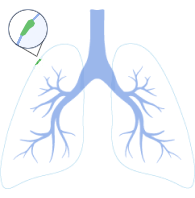
Stage 0
In stage 0 NSCLC, the cancer has just started to form. Lung cancer cells are only found in the lining of the lung airways (bronchi) but they haven’t gotten into lung tissue or any other parts of the body.
This lung cancer stage is also known as the occult (hidden) stage as it may not be visible on imaging scans normally used to diagnose and stage lung cancer.
Since stage 0 NSCLC has not spread very far, doctors can often remove all of the cancer with surgery, according to the American Cancer Society (ACS).
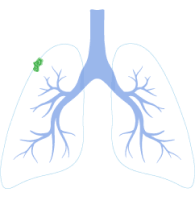
Stage I
In cases of stage I NSCLC, a small cancer tumor (less than 4 centimeters wide) has formed in one of the lungs.
There are two substages:
- IA: The tumor is under 3 centimeters wide and is just on the lung tissue.
- IB: The tumor has grown into the closest bronchus (one of two main airways), the pleura (lung lining), or is partially clogging an airway. It is bigger than 3 centimeters but less than 4 centimeters wide.
Neither substage has grown into lymph nodes or other parts of the body.
Patients diagnosed with stage I NSCLC have a better chance of being long-term survivors, since the cancer hasn’t spread very far and there are more treatment options available.
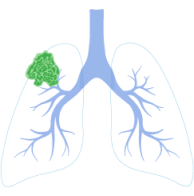
Stage II
Stage II NSCLC has spread further into the lungs and the tumors have grown slightly bigger than those in stage I. Tumors in this stage can range in size from 3 centimeters to just under 7 centimeters wide, according to the ACS.
Stage II NSCLC is notable as it’s the first lung cancer stage where the cancer spreads into the lymph nodes. Lymph nodes push fluids through your body. Sometimes, cancer cells can be picked up in this fluid and pushed to a lymph node.
Lymph nodes will kill most cancer cells they encounter. However, some cancer cells might escape destruction and hitch a ride through the lymph system, allowing the cancer to spread to other parts of the body.
Stage II substages include:
- Stage IIA: The tumors are over 4 centimeters but not 5 centimeters wide. It’s found in the same places as stage IB (the pleura or bronchus) or it could be blocking an airway. However, stage IIA NSCLC tumors are not found in the lymph nodes.
- Stage IIB: Stage IIB tumors can range in size from 3 centimeters to less than 7 centimeters wide and have grown into nearby lymph nodes. These tumors may or may not be found in the bronchus or pleura. Stage IIB tumors can also invade the chest wall or pericardium (heart lining).
There are still many treatments that can help stage II NSCLC patients live longer — even if the cancer has spread to the lymph nodes.
Learn how you can afford treatments for any lung cancer stage right now by calling (877) 446-5767.
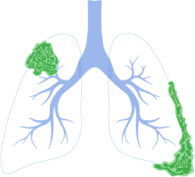
Stage III
In this lung cancer stage, the tumors continue to grow deeper into the lungs, chest, and lymph nodes. This is also the stage where many tumor nodules (growths) may be found in the lungs, as noted by the ACS.
Stage III NSCLC tumors can be found in the:
- Carina (area where the windpipe splits into the two bronchi)
- Diaphragm (muscle between the chest and abdomen)
- Esophagus
- Heart and its nearby blood vessels
- Mediastinum (area between the lungs)
- Trachea
Tumors can also be found in locations from the earlier stages (bronchi, chest wall, heart lining, etc).
The tumor size can vary greatly in this stage, from 3 to over 7 centimeters wide.
There are three substages for stage III:
- Stage IIIA: These tumors have reached lymph nodes in the lung or near the carina. Tumors may block nearby lung airways as in earlier stages.
- Stage IIIB: Tumors have reached lymph nodes near the carina, mediastinum, and/or collarbone.
- Stage IIIC: These tumors are between 5 and 7 centimeters wide or larger, and have grown into any of the sites or lymph nodes from the earlier stages.
This lung cancer stage marks the point where life-extending treatment options start to get limited. With that being said, many patients have gone on to become long-term survivors even after a stage III lung cancer diagnosis.
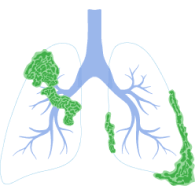
Stage IV
Stage IV NSCLC is the most advanced stage and the hardest one to treat. By this point, the cancer has spread to different body parts, some of which are far away from the lungs.
Stage IV NSCLC can affect distant organs like the:
- Adrenal glands
- Bones
- Brain
- Liver
The cancer may have also grown into any body parts or lymph nodes from the earlier stages. Further, cancer cells may be found in fluid within the linings of the lung or heart.
There are two substages of stage IV NSCLC:
- Stage IVA: One lung cancer tumor is found outside of the lungs in any other part of the body.
- Stage IVB: More than one lung tumor is found beyond the lungs.
It’s very hard to surgically remove stage IV tumors since they may have reached vital organs like the heart or brain. That said, it’s important to know that stage IV lung cancer is not always terminal. Treatments may be available to help patients live longer or with less pain. There have been reports of stage IV NSCLC patients achieving long-term survival, too.
Small Cell Lung Cancer Stages
Doctors classify cases of small cell lung cancer into two stages: the limited stage and the extensive stage.
![]() Limited Stage
Limited Stage
A patient will have limited-stage SCLC if the cancer tumors haven’t spread beyond one side of the chest, according to the American Thoracic Society (ATS). The tumors will only be found in one lung and nearby tissues or organs. The cancer could also be in nearby lymph nodes, such as those close to the collarbone or mediastinum.
![]() Extensive Stage
Extensive Stage
The extensive stage of SCLC is the equivalent of the fourth stage of NSCLC. Here, the cancer has spread to both lungs, the bone and bone marrow, the brain, or other body parts outside of the chest.
Doctors may also find cancer cells within the fluid in the lung lining just like in cases of stage IV NSCLC.
Other Staging Systems for Small Cell Lung Cancer
The American Society of Clinical Oncology (ASCO) notes that the TNM system is rarely used to stage cases of SCLC. However, when it is used, cases of SCLC will have five stages — from stage 0 to stage 4, like cases of NSCLC.
You may qualify for financial payouts if you have lung cancer. Get a free case review to learn more.
Lung Cancer Stages and Symptoms
The Cleveland Clinic states that the symptoms of lung cancer don’t often appear until the later stages. Further, Yale Medicine notes that almost 1 in 4 lung cancer cases won’t produce symptoms, no matter the stage.
Some patients may experience symptoms in the early stages, though. Both types of lung cancer share the same set of symptoms.
- Bloody mucus
- Chest pain that worsens over time
- Hoarseness
- Infections that keep coming back
- Partial lung collapse
- Pneumonitis (inflamed lung tissue)
- A worsening cough or wheeze
Early-stage lung cancer symptoms could be mild at first. As a result, patients might not see a doctor until these symptoms have worsened and others have appeared.
- Bone pain
- Drooping eyelids
- Headaches
- Fatigue
- Weak muscles
- Weight loss
Some symptoms are unique to the lung cancer’s stage. For example, those with stage IV NSCLC or extensive stage SCLC may have pleural effusions (buildup of fluid in the lung lining). Stage IV NSCLC patients may also have pericardial effusions (a buildup of fluid in the heart lining).
How Do Doctors Determine the Stage of Lung Cancer?
Doctors determine which stage a patient’s lung cancer is in using different diagnostic tests, according to Penn Medicine. The first step is for the patient to get a physical exam, where the doctor can check out their breathing and record any symptoms. The ATS notes that if the symptoms of your cancer change, it could indicate a progression of the disease.
 Doctors then use imaging tests (like X-rays, MRI scans, or CT scans) to look inside the chest for possible tumors. If the patient is suspected to have late-stage lung cancer, doctors may want to scan other parts of the body like the brain to check for tumors there too.
Doctors then use imaging tests (like X-rays, MRI scans, or CT scans) to look inside the chest for possible tumors. If the patient is suspected to have late-stage lung cancer, doctors may want to scan other parts of the body like the brain to check for tumors there too.
Doctors will then need to take a biopsy (fluid/tissue sample) to confirm if the tumors are indeed lung cancer. Doctors often get this sample with a bronchoscopy, where a tiny tube with a camera and extractor is fed down the windpipe and into the lungs. Nearby lymph nodes that could also be cancerous may be removed during a biopsy in some cases too.
Once this is done, specialized doctors called pathologists can look at the lung sample under a microscope to see if there are cancer cells present and confirm the stage of the cancer. It typically takes a couple of weeks to get the results from a biopsy back.
Most patients are diagnosed in the later stages of lung cancer.
- A stage 0 diagnosis of NSCLC is very rare since the cancer is often not seen on imaging scans in this stage, according to the ACS. However, cancer cells may be found in sputum (mucus coughed up from the lungs) at this stage, which can help doctors catch the cancer before it spreads.
- Roughly 2 in 3 SCLC patients will be diagnosed in the extensive stage, according to ASCO.
- Between 60% and 70% of all NSCLC cases are diagnosed in stage IV, according to a 2021 study from the medical journal Frontiers in Oncology.
Lung Cancer Stages and Prognosis
The stage at which lung cancer is diagnosed greatly impacts a patient’s prognosis (expected health outlook after a diagnosis). Generally speaking, those diagnosed with late-stage lung cancer have a worse prognosis. The more advanced the stage, the more the cancer has spread and the harder it is to treat.
Prognosis is measured using survival rates and life expectancy. A survival rate is the number of patients still alive after a certain span of time has passed (usually years).
- Stage I 5-year survival rate: 70-90%
- Stage II 5-year survival rate: 50-60%
- Stage III 5-year survival rate: 20-40%
- Stage IV 5-year survival rate: 3-7%
Life expectancy is how many months a patient lives on average after their diagnosis. Most NSCLC patients have longer life expectancies when compared to SCLC patients.
Non-Small Cell Lung Cancer Stages & Life Expectancies
- Stages I & II: 33-55 months
- Stage III: 12-28 months
- Stage IV: 4-9 months
Small Cell Lung Cancer Stages & Life Expectancies
- Limited Stage: 14-20 months
- Extensive Stage: 8-13 months
Though these lung cancer life expectancy and survival rate statistics can seem scary, remember that they’re only averages. It may be possible to live for years or even decades after your diagnosis regardless of what lung cancer stage you have.
A 2021 study from Frontiers in Oncology noted that 25-30% of stage IV NSCLC patients live less than 3 months after a diagnosis. However, patients that do not pass away after those 3 months can sometimes live for 10 or 15 years.
Get help after a lung cancer diagnosis: Call (877) 446-5767 now.
Lung Cancer Treatment by Stage
Medical treatments can help patients with any stage of lung cancer. Lung cancer treatments are key to living longer and easing the symptoms.
“Even if the lung cancer is detected late and cure becomes unlikely, treatment can prolong life and more importantly can alleviate the symptoms. And the earlier you detect any cancer, the more likely that you will have a cure.”
— Dr. George Eapen, MD Anderson Cancer Center pulmonologist
Stage and other factors greatly impact a patient’s cancer treatment plan (such as which treatments will be used and when they are given). Learn about common lung cancer treatment options below.
Surgeries
 Lung cancer surgeries allow doctors to remove the cancer tumor and nearby tissues or organs it has grown into (usually part or all of a lung).
Lung cancer surgeries allow doctors to remove the cancer tumor and nearby tissues or organs it has grown into (usually part or all of a lung).
Surgeries are commonly recommended for patients with stage I, stage II, and stage IIIA NSCLC. Doctors can also remove cancerous lymph nodes in cases of early-stage NSCLC.
ASCO notes that surgery is not usually used for late-stage NSCLC cases as the cancer has spread and cannot be completely removed.
Surgery is only used to treat SCLC if it’s caught in the very early stages, according to the ACS. Less than 5% of SCLC patients qualify for surgery since most are diagnosed in the extensive stage.
Chemotherapy
Chemotherapy (cancer-destroying medication) can be used to treat all stages of lung cancer.
In cases of early-stage NSCLC, doctors often use chemotherapy to supplement the effects of surgery. Chemotherapy can kill microscopic cancer cells that weren’t surgically removed. Chemotherapy may be the main treatment used in late-stage NSCLC when surgery is no longer an option, according to the ACS.
The ACS also notes that chemotherapy is combined with radiation to treat limited-stage SCLC and is used as the frontline treatment for extensive-stage SCLC.
Immunotherapy
Immunotherapy medications improve the body’s immune response so it can destroy cancer cells. Immunotherapy treatments can be used with chemotherapy, surgery, and/or radiation to help NSCLC and SCLC patients live longer.
Different immunotherapy medications can be used depending on the cancer stage. Some can be used to treat many stages of lung cancer while others only work for specific stages when combined with other treatments, according to the ACS.
Radiation Therapy
Doctors can use radiation therapy (concentrated beams of energy) to kill lung cancer cells.
Radiation may be used to augment surgery in early-stage NSCLC patients. If the cancer has started to spread but hasn’t reached distant organs like the brain, radiation can also be used alongside chemotherapy to treat late-stage NSCLC.
In early-stage SCLC, radiation is often combined with chemotherapy to treat patients. Radiation may also be used in some cases when the patient has extensive SCLC to shrink tumors and ease symptoms.
Targeted Therapy
Targeted therapy is a medication, taken in a pill form, that attacks the genes in lung cancer cells that help them divide. As of 2022, targeted therapy drugs are only approved for use in treating NSCLC.
There are five targeted therapy drugs approved for use in treating NSCLC. Many of them are the first treatment that late-stage NSCLC patients receive, according to the ACS. One of the targeted therapies, osimertinib (Tagrisso), can also be used after surgery to help early-stage NSCLC patients.
Clinical Trials
Lung cancer patients at any stage may qualify to join a clinical trial. Doctors and researchers test new treatments (or changes to existing treatments) through these trials with the hopes of helping patients live longer.
Patients will need to meet set criteria outlined in the trial in order to join. For example, some trials may only be open to those with a specific stage of lung cancer. Doctors can help see if there are any clinical trials that their patients may qualify for.
Get Help for Any Lung Cancer Stage
All stages of lung cancer are very concerning, but the good news is that doctors are well-equipped to help you. Medical care is available for all stages of lung cancer and there are cancer centers across the country that treat lung cancer every day.
Treatments for any stage of lung cancer can be expensive, but you may qualify for financial aid. Lung Cancer Group can help you access this financial compensation if you qualify. Learn more now with a free case review.
FAQs About Lung Cancer Stages
How many stages of lung cancer are there?
There are five stages of non-small cell lung cancer (which is the most common type) and two stages of small cell lung cancer.
The five NSCLC stages range from stage 0 (where the cancer hasn’t spread past the lung) to stage IV (where the cancer is found in the lungs and other body parts like the brain and bones).
The two stages of SCLC are the limited stage and the extensive stage. The limited stage means the cancer is still relatively contained to the lung. The extensive stage is more or less the same as stage IV NSCLC as the cancer has reached other body parts.
What is the life expectancy of a person with lung cancer?
The average life expectancy of someone with lung cancer depends on what stage they’re in, which treatments they receive, and many other factors.
Patients with NSCLC can live 33-55 months if they’re diagnosed in the early stages and 4-28 months with late-stage cancer.
Limited-stage SCLC patients live for 14-20 months on average, while those in the extensive stage have a life expectancy of 8-13 months.
That said, patients with any lung cancer stage can possibly live for years or decades with medical care.
Is lung cancer in the fourth stage curable?
Possibly, yes. Though stage IV lung cancer patients typically only live for a few months, it’s possible for some to live for 10 years or more with medical care, as noted by a recent Frontiers in Oncology report. These patients aren’t ‘cured’ as the cancer is still in their bodies, but it’s no longer growing.
These findings go to show that anything is possible and that even late-stage lung cancer patients have reasons to be hopeful.
 Limited Stage
Limited Stage Extensive Stage
Extensive Stage
